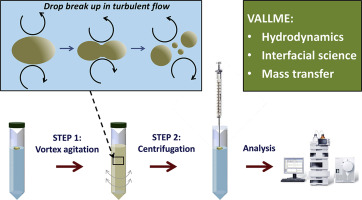Trends in Analytical Chemistry ( IF 11.8 ) Pub Date : 2018-11-14 , DOI: 10.1016/j.trac.2018.11.007 Elefteria Psillakis

|
In 2010, we proposed vortex-assisted liquid-liquid microextraction (VALLME) that used vortex agitation to disperse microliters of a water-immiscible solvent into an aqueous sample. After extraction, the two phases were separated by centrifugation and the extracting solvent was collected and used for analysis.
The seemingly easy steps of VALLME involve complex and poorly understood processes that require consideration of solvent drop breakup and coalescence plus the problem of interphase analyte mass transfer. The overall aim of this review is to transfer knowledge from other disciplines and improve current understanding of VALLME. Initially, the fundamental hydrodynamic and interfacial science concepts of emulsion formation and phase separation applying to VALLME are presented. Building on this knowledge, the effects of several experimental parameters on VALLME are discussed. Advancing the current (and limited) knowledge on the fundamentals behind VALLME is critical to allow cognitive control and full exploitation of the method.
中文翻译:

再谈涡流辅助液-液微萃取
在2010年,我们提出了涡旋辅助液-液微萃取(VALLME)技术,该技术利用涡旋搅拌将微升与水不混溶的溶剂分散到水性样品中。萃取后,通过离心分离两相,并收集萃取溶剂并用于分析。
VALLME的看似简单的步骤涉及复杂且知之甚少的过程,这些过程需要考虑溶剂滴的破裂和聚结以及相间分析物传质的问题。这篇综述的总体目的是转移其他学科的知识,并增进当前对VALLME的理解。最初,介绍了应用于VALLME的乳液形成和相分离的基本流体力学和界面科学概念。在此知识的基础上,讨论了几个实验参数对VALLME的影响。推进有关VALLME背后基础知识的(有限的)当前知识对于实现认知控制和对该方法的充分利用至关重要。
















































 京公网安备 11010802027423号
京公网安备 11010802027423号